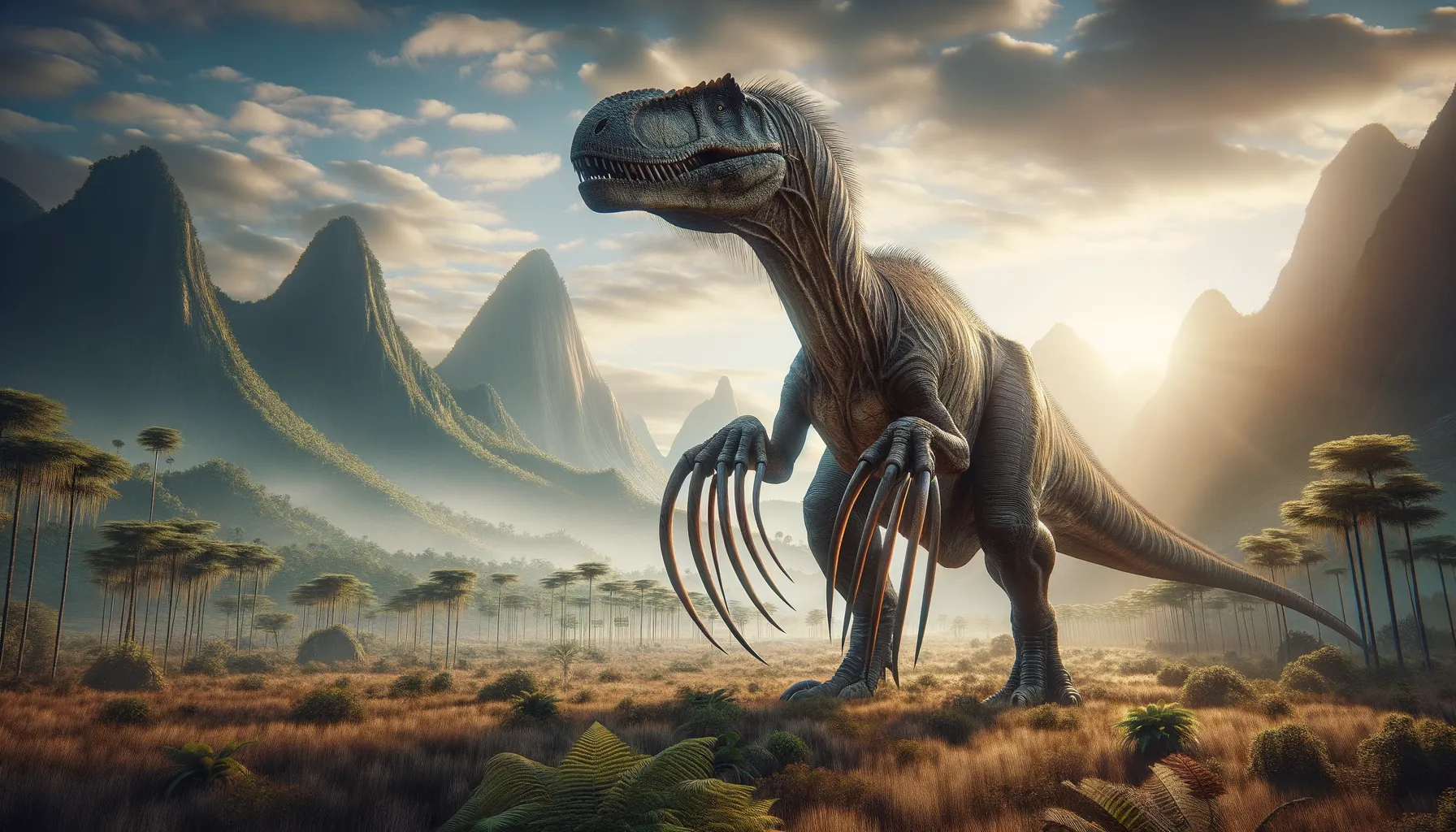
Therizinosaurus
Claws that tower over its foes.
Period
Cretaceous
Length
Could reach 33 feet in length (10 meters).
Height
Up to 16 feet tall (around 5 meters).
Weight
Approximately 3,000 pounds (1,360 kilograms).
Therizinosaurus was a large, herbivorous dinosaur with long claws, which gave it a unique appearance among prehistoric giants. Despite its intimidating look, it primarily fed on plants. Residing during the Late Cretaceous period, its fossils have mostly been found in Asian regions. It represents one of the prime examples of dinosaur evolution, with distinctive adaptations that set it apart from many of its contemporaries.
Diet
Therizinosaurus was primarily herbivorous, consuming a large variety of plants and foliage available during its time. Its long claws might have been used to pull down branches to reach leaves or peel bark from trees.
Hunting
As an herbivore, it did not hunt but may have used its claws for defense against predators. Its grazing habits meant it would travel to find the best food sources, likely avoiding confrontation with carnivorous dinosaurs.
Environmental challenges
Living during the Late Cretaceous meant facing fluctuating climates and evolving ecosystems. Predation by large carnivorous dinosaurs posed a significant threat. Additionally, it had to find enough food to sustain its massive size, which could be difficult with changing vegetation patterns and seasonal shifts in the ecosystem.
Speed
Relatively slow due to its large claws and body size.
Lifespan
Believed to have lived up to 30 years.
First discovery
Discovered in 1948 in Mongolia by Russian paleontologists.
Fun Facts
- Therizinosaurus is known for its incredibly long claws, which could grow up to 3 feet long, making them the longest claws of any known animal.
- Despite its fearsome appearance, Therizinosaurus is believed to have been a herbivore, using its claws to help gather foliage.
- It lived during the late Cretaceous period, around 70 million years ago, in what is now Mongolia.
- Originally, Therizinosaurus was thought to be a turtle because of its unique claws until more complete fossils were found.
- The name 'Therizinosaurus' means 'scythe lizard,' a reference to its scythe-like claws.
- Therizinosaurus is part of a group called theropods, which interestingly includes both carnivorous dinosaurs like Tyrannosaurus rex and modern birds.
- Its discovery helped paleontologists rethink dinosaur classification, widening the understanding of dinosaur diversity.
Growth and Development
Therizinosaurus had a slow but steady growth rate typical of large dinosaurs, reaching full size over several decades. The development of its distinctive claws likely progressed gradually, culminating in the formidable appendages seen in adults. Hatchlings would have been significantly smaller, depending on more protective terrain against predators during their vulnerable early years.
Habitat
Therizinosaurus lived in a range of environments that included floodplains and forested areas, providing access to ample plant life for sustenance. The seasonal changes in these habitats influenced their movement, as they likely migrated following food availability. Water sources were crucial, as they needed hydration to support their large bodies and to maintain healthy dietary habits.
Interaction with other species
As a herbivore, it coexisted with a range of both herbivorous and carnivorous dinosaurs. Competition for resources with other herbivores influenced its feeding behavior. Predatory species were a significant threat, likely shaping its defensive adaptations. Interactions among its own species might have included social behaviors such as group living for improved defense.
Natural lifespan
Its natural lifespan could reach up to 30 years.
Reproduction
Therizinosaurus reproduced by laying eggs, likely in nests similar to those of modern birds. Parent dinosaurs may have displayed some level of care for their laid eggs, defending them against predators. Hatchlings would have been independent shortly after birth, growing rapidly to avoid predation.
Social behaviour
Therizinosaurus may have lived in small groups or herds, offering safety in numbers. This social structure could have helped with defense against predators. Cooperative behaviors might have led to more effective feeding strategies, especially in areas where food was plentiful.
Fossil locations
Fossils of Therizinosaurus have been predominantly found in Mongolia. The discovery in the Gobi Desert has provided significant insights into its anatomy and lifestyle. The preserved remains offer critical data for understanding its evolutionary line and habitat preferences, enabling scientists to piece together the ecological dynamics of the era.
